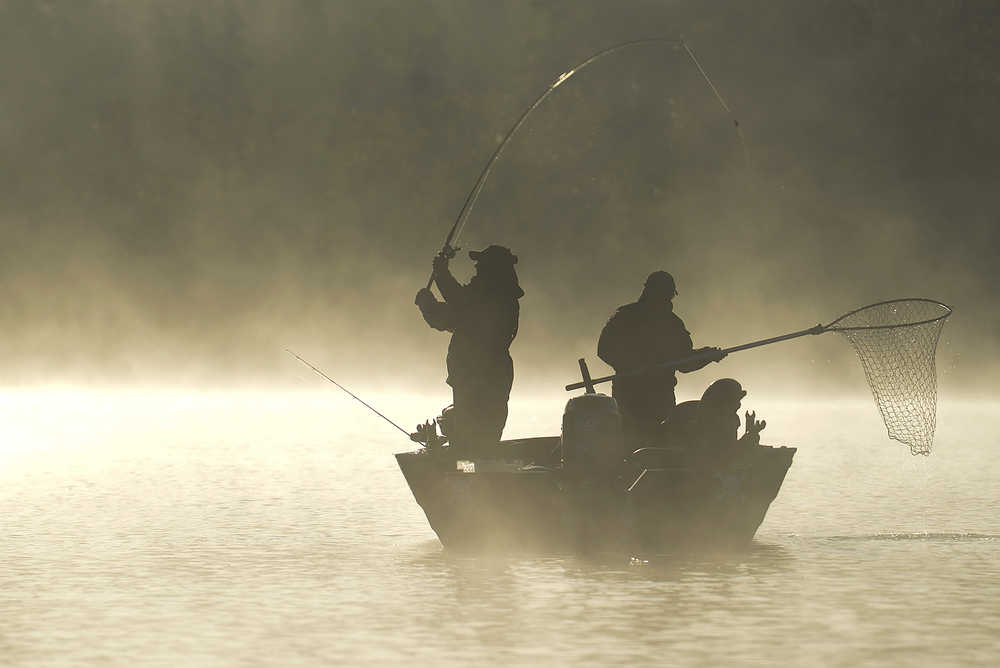It’s not something they like to talk about, but the Fenton brothers figured out a new way to fish for sockeye salmon on the Kenai River in recent years.
Without giving away too many details, it involves plugs and a relatively serene area of the river — but that’s about all of the detail Mike Fenton, co-owner and guide at Fenton Bros. Guided Sportsfishing Alaska LLC., was willing to say on-the-record.
“We’ve been doing it for quite a while and, obviously, I tried to keep it on the down low just because it’s a pretty effective way to catch those things,” he said. “But, the cat’s kind of out of the bag … it’s everybody’s river out there.”
The brothers have been offering the option to their clients for years, partially because it was a different kind of fishing experience than what one could normally get on the famed Kenai River. But, Fenton said, it was also an innovation in response to uncertainty in the increasingly restrictive king salmon seasons that used to be the bread and butter of a viable fishing guide business on the central Kenai Peninsula.
“We’ve definitely had to learn to adapt and instead of selling a fishing trip now that’s ‘Hey, we’re going to take you and your grandfather from Texas king fishing in June,’ we kind of changed our attitude and said ‘Hey, we will take you fishing, we’re just not exactly sure where or what we’ll be able to do,’” Fenton said.
Volatility in the king fishery has certainly caused a drop in the number of guides on the Kenai River. According to data from Alaska State Parks, the number of guides registered to fish on the Kenai River has been in steady decline since 2007 when it peaked at 396 guides before dropping to 284 during the 2013 fishing season.
The year the number of guides on the river peaked, Fish and Game data showed the early run of Kenai River king salmon, and king stocks statewide begin to decline.
“…Abundance declined from 2007-2009 and stayed at this bellow or well-below average abundance,” said area management biologist Robert Begich in a 2013 interview.
Fenton said he has seen a decline in returning king numbers for about a decade and each year, Fish and Game managers restrict the fishery even further to protect the dwindling stocks.
“We started sometimes with shortened seasons, changes in gear type regulation, down to one hook from multiple hooks, bait to no bait and along with that, we’ve seen the size and number of the larger kings diminishing,” he said.
What was once the most unique attraction on the Kenai River has become a sideboard to fishing trips that often include rainbow trout, sockeye, coho, marine or fly-out fishing and halibut trips.
“You just have to learn to adapt,” Fenton said.
For Rod Berg, co-owner of Rod ‘N Real, the closure of the early run king salmon fishery in 2014 was another blow to the guided sportfishing industry — one that he has seen undergo drastic changes in the 30 years he has been working on the Kenai River. He has opened his guiding business up in a different way.
In 2014, Berg said the focus for his business was on sockeye and silver salmon trips — Rod ‘N Real guides took clients on sportfishing trips and they took Alaskans on personal-use dipnetting trips, though personal-use guiding is a smaller portion the business.
“We haven’t really relied on (dipnetting),” he said during a 2014 interview. “We don’t want to start relying on it, because I don’t think it’s going to last, personally … It worked out for some guys and it’s something we’re probably going to be forced to do more and more if these kings don’t turn around.”
Berg said the whole model for sportfish guiding on the Kenai Peninsula will have to change to stay viable.
“We added clam trips to the other side of the Inlet, we offer eco-tours, things like that,” he said. “But how do you go from a harvest-type industry to an eco-tourism type thing? It is really hard to incorporate the two and we’ve had to farm out a lot of our business.”
On the Kenai River, that adaptation has led to guides bringing anglers into lower parts of the river, earlier in the fishing season on the hunt for rainbow trout — or finding clients who are happy to catch-and-release fish for the famed king salmon.
Anglers have also shifted focus from the Kenai River to other parts of the Kenai Peninsula, he said.
“There’s great fishing out of Whittier … a lot of people tend to — if they get a boat big enough — a lot of times, they’ll camp out on some of the islands and just stay out for a couple of days,” he said.
Others head to Seward for marine fishing, he said.
While Fenton and his brother have found a balance between working their other jobs, innovating in the Kenai River fisheries and attracting a new type of conservation-minded client — Fenton said he still saw the declining Kenai River guide numbers as a blow to the industry.
“I can’t see the future being very robust in regards to … any new number of guides coming into the industry and being able to survive, other than strictly doing it as a hobby,” he said. “It’s tough for these young guys.”
Reach Rashah McChesney at Rashah.mcchesney@peninsulaclarion.com.
